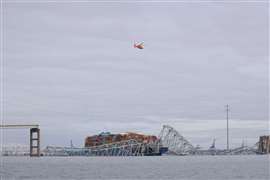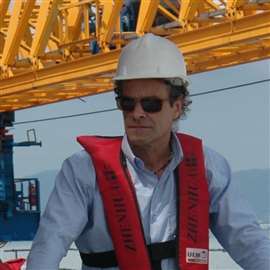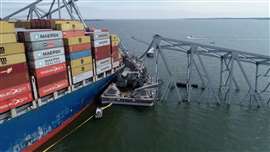Baltimore bridge collapse: Can engineers prevent similar disasters?
02 April 2024
The world watched in horror last week as Baltimore’s iconic Francis Scott Key Bridge collapsed into the Patapsco River, killing six construction workers. Lucy Barnard asks what engineering and construction companies can do to prevent the risk of something like this happening again.
The world looked on in horror last week as Baltimore’s Francis Scott Key Bridge collapsed after one of its supports was struck by a Singapore-flagged Dali cargo ship.
At the time of writing, the search for six missing construction workers thought to have been repairing potholes on the bridge has been called off. Two others were pulled from the water during a search and rescue operation.
Currently, teams of engineers have begun the intricate process of cutting and lifting the first section of the collapsed bridge. A recovery team led by the US Coast Guard and the state of Maryland aims to quickly reopen the port, the largest in the US for “roll-on, roll-off” vehicle imports and exports of farm and construction equipment.
Teams are still investigating what exactly happened to cause the steel arch continuous through truss bridge to topple into the freezing waters of the Patapsco River at 1:30am local time on Tuesday, March 26, in scenes which the city’s mayor, Brandon Scott, described as looking like “something out of an action movie.”
 A view of the Dali cargo vessel which crashed into the Francis Scott Key Bridge causing it to collapse in Baltimore, Maryland. Photo: Reuters/ Julia Nikhinson
A view of the Dali cargo vessel which crashed into the Francis Scott Key Bridge causing it to collapse in Baltimore, Maryland. Photo: Reuters/ Julia Nikhinson
What is known is that 45 minutes after departing the Baltimore shipping terminal at Port Breeze for the Sri Lankan capital Colombo, the Dali lost power and issued a distress call warning Maryland transport officials of a possible collision. Shortly after that it smashed into a support column on the 47-year-old bridge, causing most of the 366m main span of the 2,632m-long bridge to collapse.
“A collapse on the scale that we saw this week is pretty unusual,” says Dr. David Collings, senior technical director at engineering consultancy Arcadis. “Clearly there was a huge impact which took out a pier but this then caused a progressive collapse, bringing down the whole structure rather than just localised damage.”
Certainly, experts say that given the size of the vessel, few if any bridge piers, would have been able to withstand such a collision. The 290m-long Dali had a capacity for 10,000 containers. According to ship tracking data on MarineTraffic.com, its last registered speed before it hit the bridge was 7.6 knots between 100m and 200m from the bridge.
“It is almost impossible to design a bridge pier to withstand this kind of impact,” says Ian Firth, an independent engineering consultant and past president of the Institution of Structural Engineers. “The fact that a vessel can veer off course and hit the pier is the reason to design vessel impact protection systems so that a large vessel cannot hit the critical bridge support.”
Engineers point out that unlike new bridges which are being constructed today, older structures were designed when huge cargo ships like the Dali had not been envisaged.
1970s bridges were designed for smaller ships
“With this bridge, when you look at the original structure, it’s pretty light and skimpy. It’s the sort of thing that was being designed in the 1970s to minimise cost and materials,” says Collings. “Since then container ships have increased in size significantly. These days, the first thing you would say is that 300m clearance between foundations for a port like that - is that enough? You would make it 500m to give the ships more room. But obviously in the 1970s they were looking at a completely different size of cargo ship. There is economic pressure in ports for bigger ships so the risk for a bridge is changing with time.”
However, experts point out that, despite the age of the bridge, its owner the Maryland Transportation Authority, was responsible for maintaining the structure and carrying out regular risk assessments to ensure its safety. Part of that process would have included a ship impact analysis considering the likelihood of an impact and assessing the consequences if one occurs.
 Dr David Collings, senior technical director at Arcadis. Photo: Arcadis
Dr David Collings, senior technical director at Arcadis. Photo: Arcadis
“Modern ship impact analysis is based on risk,” says Collings. “As part of any risk assessment, the vulnerability of the bridge to progressive collapse is important. At Baltimore unfortunately we saw a collapse progressively extending from the pier hit by the ship into the spans until the whole bridge had collapsed.”
In order to mitigate risk in legacy structures engineers employ two main techniques; firstly physical barriers which prevent ships from getting as far as the bridge piers in the first place. These can include: artificial islands in the river which surround the piers; fenders, protective barriers built around existing piers; or so-called ‘dolphins,’ groups of piles clumped together designed for the vessels to crash into first.
“Dolphins or other vessel impact protection devices in the water are commonplace since the Sunshine Skyway collapse in 1980,” says Firth. “But this bridge was built in the 1970s, so the design would not have incorporated these devices at that time. The footage shows that there are small dolphins each side of the bridge piers - these have not prevented the vessel hitting the pier.”
A second method used by engineers to protect legacy bridges from impacts is retrofitting strengthening techniques. These can include steel cables known as ‘tie downs’ which effectively reinforce strength by tying components of the bridge to their piers or strengthening the deck by adding extra steel sections.
“Tie downs are used so that the bridge doesn’t come off its piers,” says Collings. “If one span fails and the whole bridge is jolted, then the tie downs should work to ensure the side spans don’t jump off the bearings and fail as well. Deck strengthening can also be important,” he adds. “You do a whole series of complicated analysis to check and recommend strengthening of certain parts to make sure it can stay up.”
Other recent ship collisions
The Francis Scott Key Bridge is not the only major bridge to have suffered similar collision damage in recent years.
On February 22, 2024, just a month before the Baltimore tragedy, five people were killed and two injured when a portion of the Lixinsha Bridge on the Hongqili Waterway in Guangzhou, China was struck by a barge - Lianghui 688 - causing a part of the 1990s built bridge to break off.
 Drone image shows the collapse of Baltimore’s Francis Scott Key Bridge after it was hit by by Cargo Ship Dali on March 26, 2024. Photo: National Transportation Safety Board handout via EYEPRESS via Reuters
Drone image shows the collapse of Baltimore’s Francis Scott Key Bridge after it was hit by by Cargo Ship Dali on March 26, 2024. Photo: National Transportation Safety Board handout via EYEPRESS via Reuters
In 2019, an 860m-long bridge over the Moju Rover, close to the Brazilian port of Belém, collapsed after a ferry boat struck one of its pillars.
And in 2016, two spans of the 100-year-old Ghenh railway Bridge across the Dong Nai River in Vietnam collapsed after a barge crashed into one of its piles.
In fact, according to a 2018 report by the World Association for Waterborne Transport Infrastructure, 35 major bridges around the world collapsed in the years between 1960 and 2015 due to ship or barge collisions, killing a total of 342 people.
And these bleak figures underly deeper concern about the wider safety of aging bridges around the world.
According to the American Society of Civil Engineers’ 2021 report card for America’s infrastructure, around a third of the country’s 222,000 bridge spans and 76,000 bridges either need repairs or need to be replaced. It says that about 42% of the nation’s 600,000 highway bridges are over 50 years old and about 12% were 80 years old or more. A similar picture emerges in other Western countries with UK local authorities identifying 2,928 road bridges across England, Scotland and Wales as substandard in 2023.
“Unfortunately this sort of disaster is not that unusual,” says Collings. “It’s actually something that happens pretty regularly. These kinds of retrofits cost and there are a lot of legacy bridges. So what you’re getting with existing bridges is that somebody does the risk assessment and the cost benefit analysis and says it isn’t worth it. High-profile disasters like the one in Baltimore do change attitudes so we may well see some changes come from this.”
|
MAGAZINE
NEWSLETTER
CONNECT WITH THE TEAM






